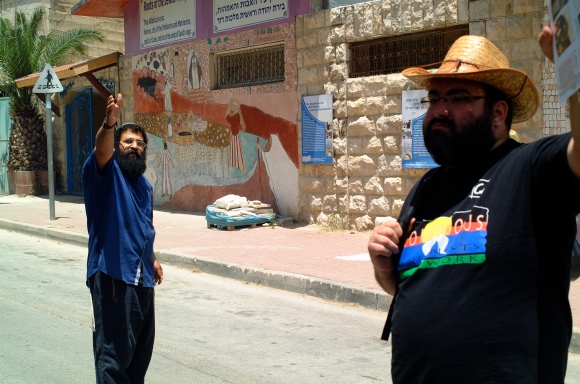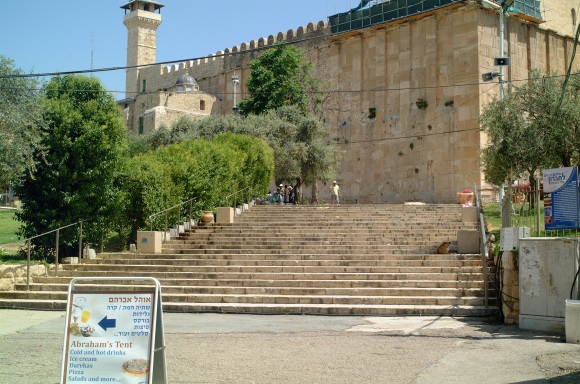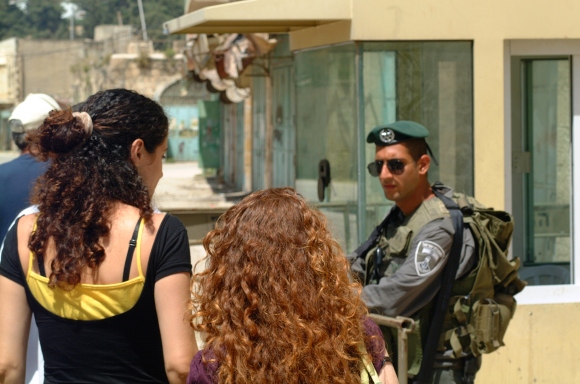As Israel turns in on itself, focusing on the multitude of social and economic problems facing the country, the West Bank continues to drift further away from the country’s collective consciousness. But how long will the relative quiet in Hebron last?
On Friday May 18th I participated in a tour with “Breaking the Silence”, a group of former IDF combat soldiers. The following photo-essay shows a day-in-the-life of Hebron in 2012, and how in this city, even a minor incident can cause things to rapidly spin out of control…

Palestinian children walking down a deserted Hebron street. To the right is a white tent built by settlers which has been torn down repeatedly by the IDF. Each time requires at least 300 soldiers.

The official Israeli checkpoint for passage in and out of the West Bank, far beyond the internationally recognized 1967 “Green Line” which itself has no discernable markers. The so-called checkpoint looks more like an innocuous European-style border crossing between countries, providing a sense of normalcy for Israelis and other privileged visitors to an otherwise abnormal system of military government.
Revered by both Jews and Muslims as the final resting place of the Patriarchs and Matriarchs of the Bible, the Me’arat Ha-Machpela or Al Haram al-Ibrahimi in Arabic is also the site of the 1994 massacre by the Brooklyn-born settler, Baruch Goldstein. Goldstein’s killing of 29 Muslims and wounding 125 is widely regarded as one of the major causes for the outbreak in Palestinian suicide attacks and the consequent derailment of the Oslo peace process.
Palestinian child looks-on at the rare sight of Israeli civilian visitors from the other side of the roadside barrier which divides Jews and Muslims along Hebron’s main Shuhada street, a few steps away from the Tomb of the Patriarchs. Since the outbreak of the Second Intifada in October 2000, Palestinians are forbidden from travelling by car or opening shops in the city center. Despite attempts by Israeli NGOs to improve conditions through legal action, Palestinian freedom of movement, even by foot is severely restricted in Hebron to this day.
A Sunglasses-clad military border policeman surveys the scene, as the group continues down Shuhada Street. Often confused by foreign media outlets as “Israeli soldiers”, the border police or “magavnikim” in Hebrew shorthand are actually a branch of the Israel National Police and not the military. Even so, young Israelis can choose to volunteer for Magav at the age of 18 as part of their three-year mandatory military service. Those that do so are usually motivated by ideology as the unit has regular contact and confrontations with Palestinians, particularly at checkpoints.

Once the scene of a busy marketplace selling fruits, vegetable and meats much like Jerusalem’s Machane Yehuda “shuk”, this stretch of Shuhada street is still a virtual ghost-town or as is common in army parlance, “sterilized” of Palestinians. The only movement that can be found is bizarrely of a jogger (in orange), an armored police vehicle and a solitary soldier whose silhouetted figure can just be made out in the background.

Yehuda Shaul, one of the founders of the Israeli NGO, “Breaking the Silence, and the “tour leader” for the day’s excursion through Hebron. Shaul, a former soldier who served for years in Hebron during the Second Intifada, is a religiously observant Jew with close family, including a sister that lives in the settlements. Breaking the Silence strictly define their role as that of “providing education and information”, particularly for Israelis on the situation in Hebron and the surrounding area. They are quick to point out that their goal is not to suggest a “political program” for solving the conflict. Nevertheless they are unequivocally opposed to the continued occupation of the West Bank.
One of the numerous IDF soldiers we passed along the way, next to a heavily armored police vehicle. Hebron is the second largest urban area in the West Bank with a population of 166,000 Palestinian Arabs. It is the only major Palestinian city in the West Bank which Israelis are legally allowed to enter because of the three “micro-settlements” of 1,000 Jewish settlers within the actual city. Guarding these 1,000 people is a battalion-strength force of about 500 soldiers, reinforced by both regular and border police. This means that for every two settlers, there is at least one solider protecting them, the highest ratio of its kind in the West Bank. Despite these heavy outlays of money and manpower, Israel formally claims no sovereignty over Hebron. The only governing authority over the city is military rule.

“Breaking the silence” tours are usually notorious for the interruptions and antagonism they elicit from the small settler community of Hebron. While there were two minor disruptions by settlers from the area, overall local reaction to the presence of the tour group in the city was muted and bemused rather than aggressive or violent. Here a member of Hebron’s Chabad House argues that the property was acquired through legitimate means while Shaul continues to address the group, rebutting the man’s claims.

However, the day was not entirely without incident. Towards the very end of the tour, the group finally got a tiny taste of the emotionally charged nature of Hebron and the often unfair and illogical conduct of the city’s security forces. As the group attempted to enter the Tomb of the Patriarchs, a vicious verbal standoff ensued whereby the border police refused to allow the Israelis to pass through. One visibly religious and senior-looking officer instructed the police troops not to say anything to any of the increasingly agitated members of the group, “not a word” and not to grant them entry under any circumstances. Threats of arrest and confiscation of photographic equipment were made, to which the group responded by shouting insults, yelling “chatzuf” or “insolent” at the magavnikim.
Despite the stern orders by his commander, the middle-aged trooper of Ethiopian origin, pictured in the foreground here, flaunted all protocol; loudly claiming that one of the group had made a racist comment against him. Here I was able to take one hasty shot of the continuing exchange between him and group member, while one of the younger military policeman (out of shot) aggressively urged me to move on, shouting more threats.

And suddenly, the initial complete refusal of entry was overturned in an instant. As a large American-Jewish tour group comprising both secular and religious teenagers approached the site, inexplicably the order by another officer was given to allow everyone entry. Here at the entrance to the site’s many hallways lined with “memorials” to the Patriarchs and Matriarchs, I wait behind a crowd of American tourists whose presence seems to have been the random decisive factor enabling my own access to Judaism’s second holiest place.
Breaking the Silence says that Israelis suspected of “left-wing” views are routinely barred entry to the Tomb of the Patriarchs if they don’t look “religious”. Strangely, the information materials we were given by the NGO were also temporarily confiscated upon entering the second security check area situated within the enclosure itself. On my way out, I saw a friendly-looking magavnik of about 19 or 20 years of age, intently reading one of my leaflets. “Very interesting,” he said after he reluctantly handed it back to me, clearly enjoying the colorful graphs, facts and figures contained in the materials. It seemed to sum up the very bizarre encounter, where personal whims and emotions ruled the day rather than clear orders and the fair application of one rule for all. Our unpleasant inconvenience was just that, a simple inconvenience (albeit one filled with vitriol and the threat of violence), but for the Israelis involved, it perhaps gave them a small snap-shot of what it is like to be a Palestinian, even if for only a brief moment.



